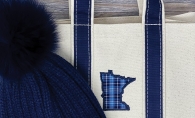Just over three years ago, Nate Houge and Micah Taylor were talking with each other about work, and how they were kind of “over it.” Houge was a musician, constantly on the road and away from his family, while Taylor, formerly a traveling musician as well, was in the corporate world, stuck in a cubicle. Houge had been a home baker for years, and the two decided to test out a community supported bakery.
“In January 2014 we put our feelers on West Seventh’s Facebook group,” to see if anyone expressed interest, Taylor says. “We thought maybe a handful of people would be interested, and then more than 50 people signed up.” So the pair started Brake Bread on a two-month trial, followed by two years at a rented commercial kitchen before opening up their own retail space last May on West Seventh Street.
Before owning their own space, “we both did all the mixing, all the shaping, forming, baking, and then the delivery,” Houge says. They had limited storage, so they would “bike most of it there, bake it, cool it, package it, load it up on the trailers” and bike it to customers. Yes, bike—12 months a year.
The first reason for two-wheeled transportation? “We could afford bikes,” Houge says. “Some of it was practical. Like, if we’re just doing this to try it out, we’re not going to buy a vehicle.” And while delivering in Saint Paul neighborhoods, they discovered “it’s way faster than a car,” he says. ”I also enjoy the community connection you get on a bike.”
And yes, they bike in the winter. “The challenge is layers,” Houge says. “You want to stay warm, but not get sweaty because you have to start and stop.”
The product they’re delivering on those bikes varies, but they do have a core base. “We do five breads a day, and then have one or two each day in addition that we rotate through,” Houge says. “Sometimes those are more unique breads that have their own little following, and sometimes we just want to experiment.” One example is the pumpkin sage bread they offered last fall.
The mix of variety and consistency applies to the scones and pastries available in the store as well.
“We’re an extension of peoples’ houses,” Taylor says. “We’re baking things that people may want to, or wouldn’t be able to, or don’t have the time to do in their homes. They still want the quality and care of all those things” that could be done in the home, he adds.
As for the type of bread, Houge says, “We use the term ‘naturally leavened’ [rather than ‘sourdough’] because we’re not going for sour in the flavor profile of our breads. We’re going for more of a depth of flavor and digestibility.”
The digestibility pays off because they have several gluten-intolerant customers who swear by Brake Bread’s whole-wheat offerings because “they can digest them just fine,” Houge says, but adding that the breads are not gluten-free.
Still settling into their new digs, they say they don’t have any big plans other than to maybe expand the patio seating. Just like baking bread, “good things take time,” Taylor says.
The Perfect Brew
Make a great cup of coffee with tips from Claddagh Coffee.
The day after St. Patrick’s Day, you might need to give yourself a little extra kick to get going. Brew yourself a perfect cup of coffee with help from Saint Paul’s Irish coffee shop, Claddagh Coffee. Owner Mary Hogan-Bard offers these tips for the best brew at home:
1. Hogan-Bard is a fan of pour over coffee, saying it offers “the freshest brew.”
2. Use good coffee. Claddagh uses and sell bags of Dogwood and Bootstrap (both local roasters).
3. Grind fresh beans. For a pour-over, measure 24 grams of beans to 12oz. or 380 grams of hot water. It is a slow pour that starts with a pre-infusion of wetting the grounds with very little water. Let grounds sit for 30-45 seconds to let the gases bubble out. Next pour the rest of the water slowly. Total time for brewing should be 3 minutes. (You can always look up pour overs on YouTube for directions.)
4. For home coffee pots, the rule for a good bold cup is to measure 1 heaping tablespoon to a cup of water.









